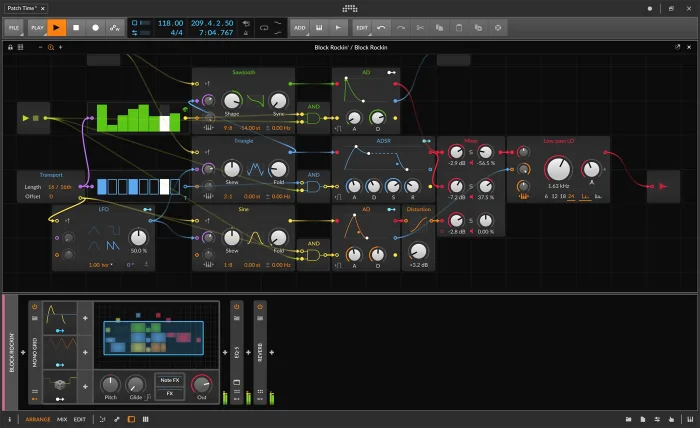After announcing The Grid this January, Bitwig has now launched the public beta of Bitwig Studio 3, which starts today.
This beta is available for all Bitwig Studio license holders with an active Upgrade Plan within their user accounts.
The Grid
As was hinted at from the start, Bitwig Studio was always intended to provide a fully-modular sound design option and this has become a reality with The Grid.
The Grid is a modular sound design environment built into two new devices: Poly Grid and FX Grid.
These Grid devices work in the same way while allowing for different configurations. Want to build a polyphonic synth? Start with Poly Grid. Need an adaptive audio effect with your signature sound? FX Grid will chew up incoming audio, either gently or otherwise. In the mood for cascading drones? Either device can be a great workbench for you, since both can handle incoming notes and audio and are equipped with Bitwig’s unique Voice Stacking for dynamic layering. And when your idea morphs, just convert what you’ve started to the other device.
Sporting 140+ Grid modules and a supersonic patching workflow, The Grid is a truly modern modular patching environment that lives within its family of new devices. Ideal for designing sounds and harnessing synthesis.
Natively part of Bitwig Studio
As a new, native element in Bitwig Studio, The Grid is accessible in myriad ways:
- Grid devices can be nested or layered along with other devices and plug-ins, and they are controllable via MIDI mapping and from the Open Controller API.
- Song position is available as a sample-accurate signal, locking a patch in The Grid to the project’s timeline. And since Bitwig Studio can sync with various techniques including Ableton Link, so can The Grid.
- Arranger or clip-based automation can be added for any parameter in grid patches, even in combination with Bitwig Studio’s existing modulators.
- Grid modules like envelopes, LFOs, and sequencers all have modulator outputs as well. And just as Bitwig Studio’s modulators can control any parameter in The Grid, any grid signal can be used to modulate child devices.
- With dedicated grid modules for sending any control, trigger, or pitch signal as CV Out and receiving any CV In, hardware can be seamlessly integrated with The Grid.
Under the Hood
The technology powering The Grid is as it should be: working, felt, and transparent.
Here’s a taste of what Bitwig has done.
- In The Grid, all signals are created equal — and 4x-oversampled for the highest sound quality. All signals are interchangeable so any out port can be connected to any in port.
- Every signal is stereo. That includes control signals, which indirectly affect audio. And plenty of modules can Stereo-ize signals, adding variety where needed.
- With The Grid’s quick workflow gestures, new modules can be dropped directly onto ports, automatically wiring them into your patch. And for signals that are needed regularly, there is the option of pre-cords. These clickable icons appear beside in ports, allowing common connections to be made wirelessly.
- Phase is the place. After pitch, timbre, and loudness, phase is the essential element of sound, capable of driving basic time functions, complex modulation synthesis, and so much more. With a dedicated category of phase modules, these concepts have been made freshly accessible and newly relevant for modern music production.
And while The Grid is the focus of Bitwig Studio 3, other new features — an optional realtime ruler when you need to plan in minutes or hours; signal meters within each input chooser for seeing the signal you are looking for; and general display and style improvements to aid common workflows — are already in the public beta.
The expected release is in Q2 2019. It is a free upgrade for all Bitwig Studio customers with an active Upgrade Plan.
You can visit the Bitwig booth (E241) at Superbooth19 and learn firsthand about Bitwig Studio 3 and The Grid. Bitwig will also host a lecture at Studiobühne (H318). In this lecture Dave Linnenbank will explore important concepts for constructing synthesizers, adaptive audio effects, and other performable structures.
More information: Bitwig
 Save up to 95% in Plugin Boutique's Spring Sale!
Save up to 95% in Plugin Boutique's Spring Sale!

